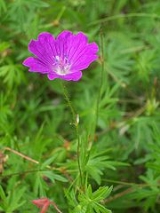
Geranium sanguineum
Encyclopedia
Geranium sanguineum, commonly called Bloody Cranesbill or Bloody Geranium, is a perennial herbaceous
plant
species in the Geraniaceae
family. It is also the county flower of Northumberland and equally the county's affiliated ship, HMS Northumberland.
, as its overwintering buds are situated just below the soil surface and the floral axis is more or less erect with a few leaves. It has a thick rhizome
. The stems are prostrate to ascending , well developed, very branched and hairy. This plant reaches on average 30–50 cm (11.8–19.7 ) in height. The petiolate
leaves have five lobes (or segments), each segment is tripartite in large teeth. The flowers have a diameter of 2.5 to 4 cm. and are purple The flowering period extends from May through October. The flowers are hermaphrodite
and pollinated by insects (entomophily
). The most common flower visitors are Syrphidae and Hymenoptera, but also butterflies and Coleoptera. The fruit is a capsule consisting of five achene
s, with a pubescent surface.
and temperate Asia. It is widespread in most of Europe
up to Caucasus
.
Herbaceous
A herbaceous plant is a plant that has leaves and stems that die down at the end of the growing season to the soil level. They have no persistent woody stem above ground...
plant
Plant
Plants are living organisms belonging to the kingdom Plantae. Precise definitions of the kingdom vary, but as the term is used here, plants include familiar organisms such as trees, flowers, herbs, bushes, grasses, vines, ferns, mosses, and green algae. The group is also called green plants or...
species in the Geraniaceae
Geraniaceae
Geraniaceae is a family of flowering plants placed in the order Geraniales. The family name is derived from the genus Geranium. It includes both the genus Geranium and the garden plants called geraniums, which modern botany classifies as genus Pelargonium, along with other related genera.There are...
family. It is also the county flower of Northumberland and equally the county's affiliated ship, HMS Northumberland.
Etymology
The genus name is derived from the Greek γέρανος ("géranos"), meaning crane, with reference to the appearance of the fruit capsule. The specific Latin name sanguineum refers to the red color assumed by the leaves in Autumn.Description
The biological form of Geranium sanguineum is hemicryptophyte scaposeGlossary of botanical terms
Many of the terms used in Wikipedia glossaries are already defined and explained within Wikipedia itself. However, lists like the following indicate where new articles need to be written and are also useful for looking up and comparing large numbers of terms together.This glossary is incomplete;...
, as its overwintering buds are situated just below the soil surface and the floral axis is more or less erect with a few leaves. It has a thick rhizome
Rhizome
In botany and dendrology, a rhizome is a characteristically horizontal stem of a plant that is usually found underground, often sending out roots and shoots from its nodes...
. The stems are prostrate to ascending , well developed, very branched and hairy. This plant reaches on average 30–50 cm (11.8–19.7 ) in height. The petiolate
Petiole (botany)
In botany, the petiole is the stalk attaching the leaf blade to the stem. The petiole usually has the same internal structure as the stem. Outgrowths appearing on each side of the petiole are called stipules. Leaves lacking a petiole are called sessile, or clasping when they partly surround the...
leaves have five lobes (or segments), each segment is tripartite in large teeth. The flowers have a diameter of 2.5 to 4 cm. and are purple The flowering period extends from May through October. The flowers are hermaphrodite
Glossary of botanical terms
Many of the terms used in Wikipedia glossaries are already defined and explained within Wikipedia itself. However, lists like the following indicate where new articles need to be written and are also useful for looking up and comparing large numbers of terms together.This glossary is incomplete;...
and pollinated by insects (entomophily
Entomophily
Entomophily is a form of pollination whereby pollen is distributed by insects. Several insect are reported to be responsible for the pollination of many plant species, particularly bees, Lepidoptera , wasps, flies, ants and beetles. Some plant species co-evolved with a particular pollinator, such...
). The most common flower visitors are Syrphidae and Hymenoptera, but also butterflies and Coleoptera. The fruit is a capsule consisting of five achene
Achene
An achene is a type of simple dry fruit produced by many species of flowering plants. Achenes are monocarpellate and indehiscent...
s, with a pubescent surface.
Distribution
Geranium sanguineum is native from EuropeEurope
Europe is, by convention, one of the world's seven continents. Comprising the westernmost peninsula of Eurasia, Europe is generally 'divided' from Asia to its east by the watershed divides of the Ural and Caucasus Mountains, the Ural River, the Caspian and Black Seas, and the waterways connecting...
and temperate Asia. It is widespread in most of Europe
Europe
Europe is, by convention, one of the world's seven continents. Comprising the westernmost peninsula of Eurasia, Europe is generally 'divided' from Asia to its east by the watershed divides of the Ural and Caucasus Mountains, the Ural River, the Caspian and Black Seas, and the waterways connecting...
up to Caucasus
Caucasus
The Caucasus, also Caucas or Caucasia , is a geopolitical region at the border of Europe and Asia, and situated between the Black and the Caspian sea...
.

